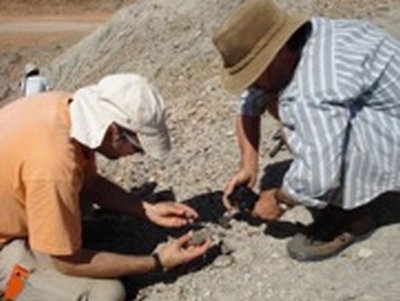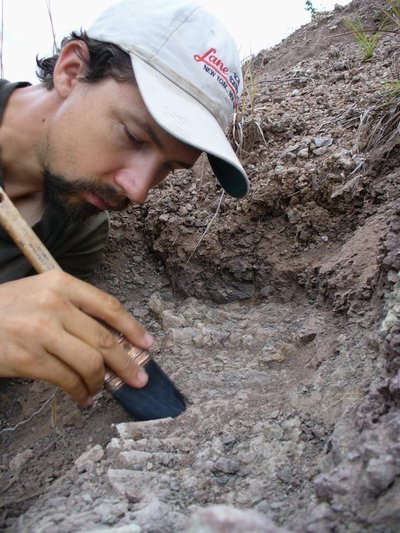March 4, 2010
Dinosaurs and their closest relatives originated earlier than thought
A team of paleontologists that includes Christian Sidor from the UW has discovered a dinosaur-like animal — one that shared many characteristics with dinosaurs but fell just outside of the dinosaur family tree — living 10 million years earlier than the oldest known dinosaurs.
The scientists conclude that dinosaurs and other close relatives such as pterosaurs (flying reptiles) might also have lived much earlier than previously thought. The description of the new species Asilisaurus kongwe appears in a paper published March 4 in Nature. The lead author is Sterling Nesbitt, a postdoctoral researcher at The University of Texas at Austin’s Jackson School of Geosciences, who conducted the research with his colleagues while a graduate student at Columbia University’s Lamont-Doherty Earth Observatory and the American Museum of Natural History.
Sidor, a UW associate professor of biology and curator of vertebrate paleontology at the Burke Museum of Natural History and Culture at the UW, is among the co-authors.
The research suggests that at least three times in the evolution of dinosaurs and their closest relatives, meat-eating animals evolved into animals with diets that included plants. These shifts all occurred in less than 10 million years, a relatively short time by geological standards.
Asilisaurus is part of a sister group to dinosaurs known as silesaurs. Silesaurs are considered dinosaur-like because they share many dinosaur characteristics but still lack key characteristics all dinosaurs share. The relationship between silesaurs and dinosaurs is analogous to the close relationship of humans and chimpanzees. Even though the oldest dinosaurs discovered so far are only 230 million years old, the presence of their closest relatives 10 million years earlier implies that silesaurs and the dinosaur lineage had already diverged from common ancestors by 240 million years ago. Silesaurs continued to live side by side with early dinosaurs throughout much of the Triassic Period, between about 250 and 200 million years ago.
This is the first dinosaur-like animal recovered by paleontologists from the Triassic period in Africa. Fossil bones of at least 14 individuals were recovered from a single bone bed in southern Tanzania, making it possible to reconstruct a nearly entire skeleton except for parts of the skull and hand. The individuals stood about 1.5 to 3 feet tall at the hips and were 3 to 10 feet long. They weighed about 22 to 66 pounds. Asilisaurus, which lived about 240 million years ago, walked on four legs and most likely ate plants or a combination of plants and meat.
Silesaurs have triangular teeth and a lower jaw with a beak-like tip that suggest that they were specialized for an omnivorous and/or herbivorous diet. These same traits evolved independently in at least two dinosaur lineages. In all three cases, the features evolved in animals that were originally meat-eaters. Although difficult to prove, it is possible that this shift conferred an evolutionary advantage. An ecosystem can support far more plant eaters than meat eaters, so being able to eat plants might have opened a broader range of habitats. Not counting modern birds, dinosaurs survived for about 180 million years.
This new species is found along with a number of primitive crocodilian relatives in the same fossil bed in southern Tanzania. The presence of these animals together at the same time and place suggests that the diversification of the relatives of crocodilians and birds was rapid and happened earlier than previously suggested. It sheds light on a group of animals that later came to dominate the terrestrial ecosystem throughout the Mesozoic Era, 250 million to 65 million years ago.
“Everyone loves dinosaurs,” said Nesbitt. “But this new evidence suggests that they were really only one of several large and distinct groups of animals that exploded in diversity in the Triassic, including silesaurs, pterosaurs, and several groups of crocodilian relatives.”
Silesaurus, the first known member of the silesaur group was discovered in 2003. In just seven short years, specimens of eight other members have been unearthed from Triassic rocks across the globe.
Other coauthors include Randall Irmis of the Utah Museum of Natural History and University of Utah, Kenneth D. Angielczyk of Chicago’s Field Museum, Roger Smith of the Iziko: South African Museum, and Linda A. Tsuji of Germany’s Museum für Naturkunde an der Humboldt-Universitat zu Berlin.
Funding was provided by The National Geographic Society, The Evolving Earth Foundation, The Grainger Foundation and The National Science Foundation.


